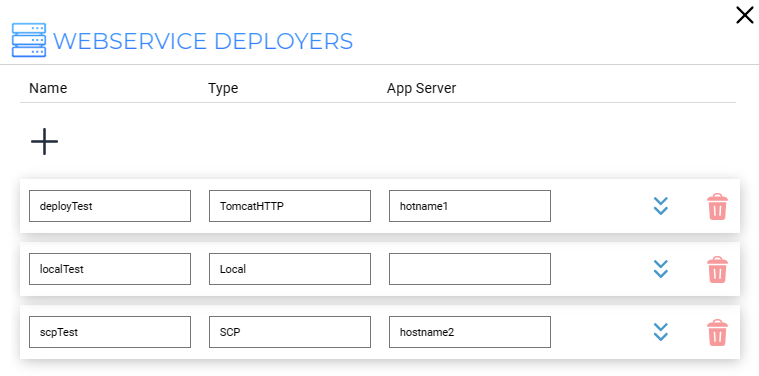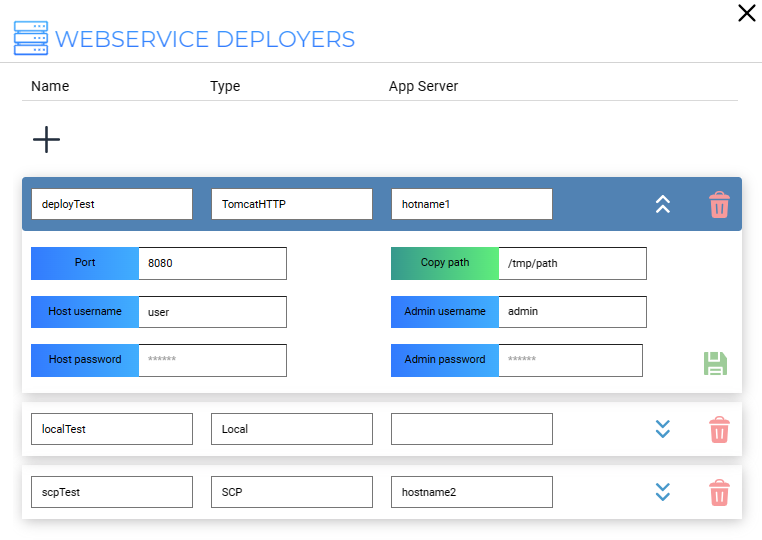The Webservice Deployers page allows you to create a new deployment entity within DTS, which can then be used to automatically deploy Webservices from their Details Dialog.

Add a new Webservice Deployer
To add a new Webservice Deployer, begin by clicking the Add button . This will reveal the Add new Webservice Deployer section.

Add new Webservice Deployer section
Select the Webservice Deployer type from the drop-down and fill in the required fields.
The dialog contains the following fields:
[Webservice Deployer] Type* |
The type of deployment that should be executed when this deployer is used. |
[Webservice Deployer] Name* |
The name given to the deployer (this is how it will be known within DTS). The name must be unique. |
Hostname* |
The hostname or IP address of the machine running the application server |
Port |
The port used to access the administrative functions of the application server |
Host Username |
The username used for logging onto the application server host machine (using SSH) |
Host Password |
The password for the Host Username |
Copy path |
The absolute path on the application server where the webservice will be copied |
Admin Username |
The username used for logging into the application server software as an administrator |
Admin Password |
The password for App Server Username |
To save an entry, click the Save button.
![]() The save button will only become available when all the required fields are filled.
The save button will only become available when all the required fields are filled.
![]() Please note that the Webservice Deployer name must be unique.
Please note that the Webservice Deployer name must be unique.
To delete an entry, click the Delete button.
![]() *These parameters are always required
*These parameters are always required
![]() The fields that are required/available depend on the Deployment Type selected in the Deployer Type field, as does the interpretation of certain fields.
The fields that are required/available depend on the Deployment Type selected in the Deployer Type field, as does the interpretation of certain fields.
Deployer Types
SCP
SCP deployment will attempt to copy the WAR archive containing the Webservice to the application server machine via SCP. This requires the application server to feature automatic deployment from a watched directory.
It requires the following parameters:
Hostname |
The hostname or IP address of the machine running the application server |
Host Username |
The username used for logging onto the application server host machine (using SSH) |
Host Password |
The password for the Host Username |
Deployment path |
The directory the application server watches for deployed service changes |
![]() If the application server is configured to only pick up changes to the watched folder on startup, a restart will be required.
If the application server is configured to only pick up changes to the watched folder on startup, a restart will be required.
Samba
Samba deployment will attempt to copy the WAR archive containing the Webservice to the application server machine via Samba. This requires the application server to feature automatic deployment from a watched directory.
It requires the following parameters:
Hostname |
The hostname or IP address of the machine running the application server |
Host Username |
The username used for logging onto the application server host machine (Windows Login) |
Host Password |
The password for the Host Username |
Deployment path |
The directory the application server watches for deployed service changes |
![]() If the application server is configured to only pick up changes to the watched folder on startup, a restart will be required.
If the application server is configured to only pick up changes to the watched folder on startup, a restart will be required.
TomcatHTTP
TomcatHTTP deployment uses a two-stage method of deployment to a Tomcat application server. In the first stage, it will copy the WAR file to a given path on the application server machine and in the second stage it will issue an HTTP request to Tomcat to deploy the Webservice from that local path.
It requires the following parameters:
Hostname |
The hostname or IP address of the machine running the application server |
Port |
The port used to access Tomcat's administrative functions (by default 9990) |
Host Username |
The username used for logging onto the application server host machine (using SSH) |
Host Password |
The password for the Host Username |
Deployment path |
The absolute path on the application server where the webservice will be copied (can be any path that both Host Username and the Tomcat OS user can access and Host Username can write to) |
App Server Username |
A username with enough administrative privileges on the Tomcat system to deploy webservices |
App Server Password |
The password for App Server Username |
![]() This deployment method is useful when using a Tomcat server that doesn't watch a directory or when connecting via SSH/Samba with a user that can write to the watched directory is not possible.
This deployment method is useful when using a Tomcat server that doesn't watch a directory or when connecting via SSH/Samba with a user that can write to the watched directory is not possible.
JBossCLI
JBossCLI deployment uses the remote console tool provided by JBoss/Wildfly application servers to deploy services.
It requires the following parameters:
Hostname |
The hostname or IP address of the machine running the application server |
Port |
The port used to access the JBoss/Wildfly administrative functions (by default 9990) |
App Server Username |
A username with enough administrative privileges on the JBoss/Wildfly system to deploy webservices |
App Server Password |
The password for App Server Username |
CLI Executable Path |
The absolute path to a locally available jboss-cli.jar |
![]() This deployment method is useful when using a JBoss/Wildfly server that doesn't watch a directory or when connecting via SSH/Samba with a user that can write to the watched directory is not possible.
This deployment method is useful when using a JBoss/Wildfly server that doesn't watch a directory or when connecting via SSH/Samba with a user that can write to the watched directory is not possible.
Weblogic
Weblogic deployment uses a two-stage method of deployment to an Oracle Weblogic application server. In the first stage, it will copy the WAR file to a given path on the application server machine and in the second stage it will use SSH to log into the same machine and use the Weblogic administration CLI on the server to deploy the webservice from the temporary path.
Hostname |
The hostname or IP address of the machine running the application server |
Host Username |
The username used for logging onto the application server host machine (using SSH) |
Host Password |
The password for the Host Username |
Deployment path |
The absolute path on the application server where the webservice will be copied (can be any path that both Host Username and the Weblogic OS user can access and Host Username can write to) |
App Server Username |
A username with enough administrative privileges on the Weblogic system to deploy webservices |
App Server Password |
The password for App Server Username |
CLI Executable Path |
The absolute path to a the Weblogic CLI tool on the app server machine |
![]() This deployment method is useful when using a Weblogic server that doesn't watch a directory or when connecting via SSH/Samba with a user that can write to the watched directory is not possible.
This deployment method is useful when using a Weblogic server that doesn't watch a directory or when connecting via SSH/Samba with a user that can write to the watched directory is not possible.
Websphere
Websphere deployment uses a two-stage method of deployment to an IBM Websphere application server. In the first stage, it will copy the WAR file to a given path on the application server machine and in the second stage it will use SSH to log into the same machine and use the Websphere administration CLI on the server to deploy the webservice from the temporary path.
Hostname |
The hostname or IP address of the machine running the application server |
Host Username |
The username used for logging onto the application server host machine (using SSH) |
Host Password |
The password for the Host Username |
Deployment path |
The absolute path on the application server where the webservice will be copied (can be any path that both Host Username and the Websphere OS user can access and Host Username can write to) |
App Server Username |
A username with enough administrative privileges on the Websphere system to deploy webservices |
App Server Password |
The password for App Server Username |
CLI Executable Path |
The absolute path to a the Websphere CLI tool on the app server machine |
![]() This deployment method is useful when using a Websphere server that doesn't watch a directory or when connecting via SSH/Samba with a user that can write to the watched directory is not possible.
This deployment method is useful when using a Websphere server that doesn't watch a directory or when connecting via SSH/Samba with a user that can write to the watched directory is not possible.
![]() Please see Webservices->Integration->Application Server for technical details and particularities regarding different Application Servers.
Please see Webservices->Integration->Application Server for technical details and particularities regarding different Application Servers.
Edit a Webservice Deployer

Edit Webservice Deployer
To edit an existing Webservice Deployer click on the respective row to view its details.
If a field has been modified, the corresponding label will turn green.
![]() Please note that the Webservice Deployer type cannot be modified.
Please note that the Webservice Deployer type cannot be modified.
![]() Please note that the Webservice Deployer name must be unique.
Please note that the Webservice Deployer name must be unique.
If some of the fields are empty or have incorrect values, their respective labels will turn red and the save button will be disabled.
The fields that contain the initial value will have a blue label.
To save your changes, click the Save button.
![]() The save button will only become available when all the required fields are filled.
The save button will only become available when all the required fields are filled.
To delete an entry, click the Delete button.

disabled save button